This article needs additional citations for verification .(May 2012) |


A fire staff is a staff constructed out of wood or metal with Kevlar wick added to one or both ends. Fire staffs are used for fire performance.
This article needs additional citations for verification .(May 2012) |


A fire staff is a staff constructed out of wood or metal with Kevlar wick added to one or both ends. Fire staffs are used for fire performance.
There are two predominant styles for manipulating a fire staff: rotational and contact. In rotational fire staff manipulation, the performer's hands are used to manipulate the motion and rotation of the staff. Contact fire staff is a technique whereby the performer rolls the staff over parts of the arms, legs and body. Both techniques can be used in a performance. Another technique is staff juggling, in which three staffs are thrown and caught.
Fire staffs can vary in length, weight, balance, and wick arrangements. A staff can range anywhere from a half-metre in length to two or more metres. Fire staffs contrast from fire knives in that their centre of balance rests in the middle of their length. The most common wick arrangement for a fire staff is two wicks of equal size and thickness on either end of the staff. However, multiple wicks may be placed on the staff, and may even be placed "out of balance", displacing the point of equilibrium. A "fire staff" with wicks on only one end of the staff, is not a fire staff – it is either a fire spear or fire spade, both of which employ vastly different movement styles than fire staff.
One of the more extreme wick arrangements for fire staff is the Dragonstaff, named after the mythical beast with the front end of an eagle and the back legs of a lion. A cross of three, four or more wicks on spokes is added to the ends, which gives the staff more rotational inertia. The dragon staff is able to create incredibly intricate patterns of fire. A Dragonstaff is similar to a contact staff in that it rolls over a performer's body and isn't held, but requires a different set of skills to manipulate because of the larger ends and the extra momentum generated by the rotation or rolling of the staff.
Fire staff technique is taught around the world at fire dance festivals, workshops and retreats. Instructional DVDs and online videos are also available.
A burnoff is a technique performed by a fire staff performer and aims to create two fireballs when excess fuel from the wicks of the staff spray outward from the spinning staff. A number of variations of the usual burnoff are possible, including the 'circular burnoff' and the 'helix burnoff'.

The long jump is a track and field event in which athletes combine speed, strength and agility in an attempt to leap as far as possible from a takeoff point. Along with the triple jump, the two events that measure jumping for distance as a group are referred to as the "horizontal jumps". This event has a history in the ancient Olympic Games and has been a modern Olympic event for men since the first Olympics in 1896 and for women since 1948.

Contact manipulation is a form of object manipulation that focuses on the movement of objects such as balls in contact with the body. Although often used in conjunction with "toss juggling", it differs in that it involves the rolling of one or more objects without releasing them into the air.

In cricket, batting is the act or skill of hitting the ball with a bat to score runs and prevent the loss of one's wicket. Any player who is currently batting is, since September 2021, officially referred to as a batter regardless of whether batting is their particular area of expertise. Historically, batsman and batswoman were used, and these terms remain in widespread use. Batters have to adapt to various conditions when playing on different cricket pitches, especially in different countries; therefore, as well as having outstanding physical batting skills, top-level batters will have quick reflexes, excellent decision-making skills, and be good strategists.

Fire performance is a group of performance arts or skills that involve the manipulation of fire. Fire performance typically involves equipment or other objects made with one or more wicks which are designed to sustain a large enough flame to create a visual effect.
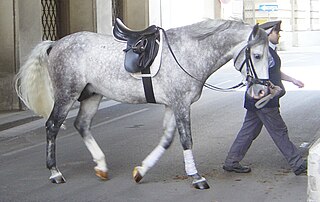
English saddles are used to ride horses in English riding disciplines throughout the world. The discipline is not limited to England, the United Kingdom in general or other English-speaking countries. This style of saddle is used in all of the Olympic and International Federation for Equestrian Sports (FEI) equestrian disciplines, except for the newly approved FEI events of equestrian vaulting and reining. Most designs were specifically developed to allow the horse freedom of movement, whether jumping, running, or moving quickly across rugged, broken country with fences. Unlike the western saddle or Australian Stock Saddle, there is no horn or other design elements that stick out above the main tree of the saddle.
Juggling practice has developed a wide range of patterns and forms which involve different types of manipulation, different props, numbers of props, and numbers of jugglers. The forms of juggling shown here are practiced by amateur, non-performing, hobby jugglers as well as by professional jugglers. The variations of juggling shown here are extensive but not exhaustive as juggling practice develops and creates new patterns on a regular basis. Jugglers do not consciously isolate their juggling into one of the categories shown; instead most jugglers will practice two or more forms, combining the varieties of juggling practice. Some forms are commonly mixed, for example: numbers and patterns with balls; while others are rarely mixed, for example: contact numbers passing. Many Western jugglers also practice other forms of object manipulation, such as diabolo, devil sticks, cigar box manipulation, fire-spinning, contact juggling, hat manipulation, poi, staff-spinning, balancing tricks, bar flair and general circus skills.

Poi is a performing art and also the name of the equipment used for its performance. As a skill toy, poi is an object or theatrical prop used for dexterity play or an object manipulation. As a performance art, poi involves swinging tethered weights through a variety of rhythmical and geometric patterns. Poi artists may also sing or dance while swinging their poi. Poi can be made from various materials with different handles, weights, and effects.

A handspring is an acrobatic move in which a person executes a complete revolution of the body by lunging headfirst from an upright position into an inverted vertical position and then pushing off from the floor with the hands so as to leap back to an upright position. The direction of body rotation in a handspring may be either forward or backward, and either kind may be performed from a stationary standing position or while in motion.

The Windmill is a popular breakdancing move. The breaker rolls their torso continuously in a circular path on the floor, across the upper chest/shoulders/back, while twirling their legs in a V-shape through the air.
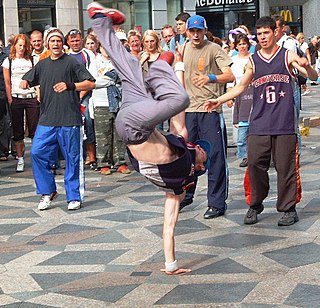
A freeze is a b-boying technique that involves halting all body motion, often in an interesting or balance-intensive pose, for a few seconds. It is implied that the position is hit and held from motion as if freezing in motion, or into ice. Freezes often incorporate various twists and distortions of the body into stylish and often difficult positions.

Static trapeze, also known as fixed trapeze, is a type of circus apparatus. In contrast to the other forms of trapeze, static trapeze the bars and ropes mainly stay in place.
A freestyle skateboarding trick is a trick performed with a skateboard while freestyle skateboarding. Some of these tricks are done in a stationary position, unlike many other skateboarding tricks. The keys to a good freestyle contest run are variety, difficulty, fluidity, and creativity. This is an incomplete list, which includes most notable tricks.
A balance board is a device used as a circus skill, for recreation, balance training, athletic training, brain development, therapy, musical training and other kinds of personal development.
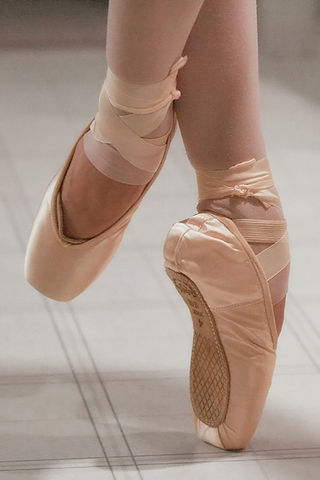
Tiptoe describes the human body posture and locomotion of removing the heel(s) of one or both feet from the ground. The term is mostly used colloquially when the weight is placed on the balls of the feet rather than literally on the tips of the toes; literal tip-toeing is difficult but possible, as in the pointe technique of ballet. In running, landing on the ball of the foot is known as forefoot strike.

Unequal leg length is often a disabling condition where the legs are either different lengths (structurally), or appear to be different lengths, because of misalignment (functionally).

The front crawl or forward crawl, also known as the Australian crawl or American crawl, is a swimming stroke usually regarded as the fastest of the four front primary strokes. As such, the front crawl stroke is almost universally used during a freestyle swimming competition, and hence freestyle is used metonymically for the front crawl. It is one of two long axis strokes, the other one being the backstroke. Unlike the backstroke, the breaststroke, and the butterfly stroke, the front crawl is not regulated by the FINA. Hence, in "freestyle" competitive swimming events, any stroke or combination of strokes is permissible. This style is sometimes referred to as the Australian crawl although this can sometimes refer to a more specific variant of front crawl.

oVo is a touring circus production by Cirque du Soleil that premiered in Montréal, Canada in 2009. oVo's creator and director, Deborah Colker, took inspiration from the world of insects. The idea for oVo was not to be about the acts, nor dancing, nor insects, but about movement. The movement of life permeates the entire show, with creatures flying, leaping, bounding, and crawling. Composer Berna Ceppas brought additional life to Ovo with a score inspired by the music of Brazil. Ovo means "egg" in Portuguese and represents the underlying thread of the show. Graphically, inside the logo of Ovo, is an insect. The two O's represent the eyes and the V forms the nose and antennas.
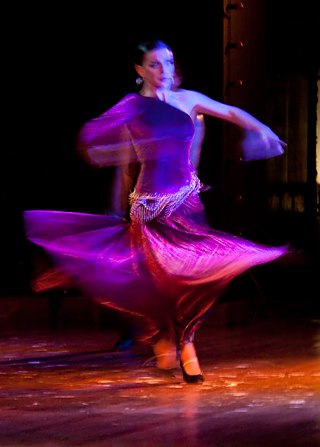
In dance and gymnastics, a turn is a rotation of the body about the vertical axis. It is usually a complete rotation of the body, although quarter (90°) and half (180°) turns are possible for some types of turns. Multiple, consecutive turns are typically named according to the number of 360° rotations.
Poi tricks are defined by the manipulation and combination of several variables of the spinning activity. These variables typically include, but are not limited to, the following:
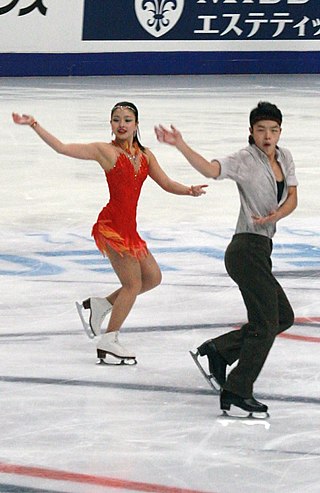
Ice dance, a discipline of figure skating, has required elements that make up a well-balanced rhythm dance program and free dance program, which must be performed during competitions. They include: the dance lift, the dance spin, the step sequence, turn sequences, and choreographic elements. The elements must be performed in specific ways, as described by published communications by the International Skating Union (ISU), unless otherwise specified. The ISU has also provided a list of illegal movements.